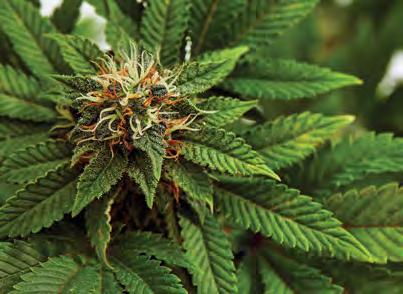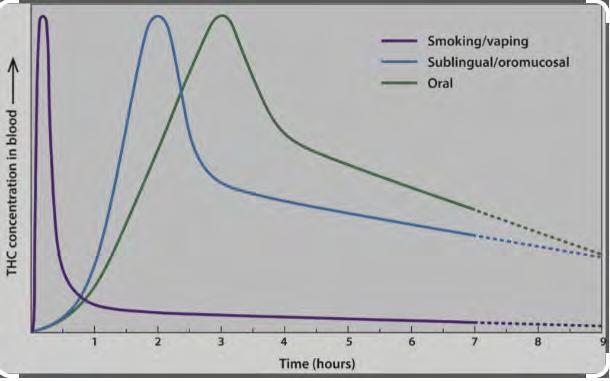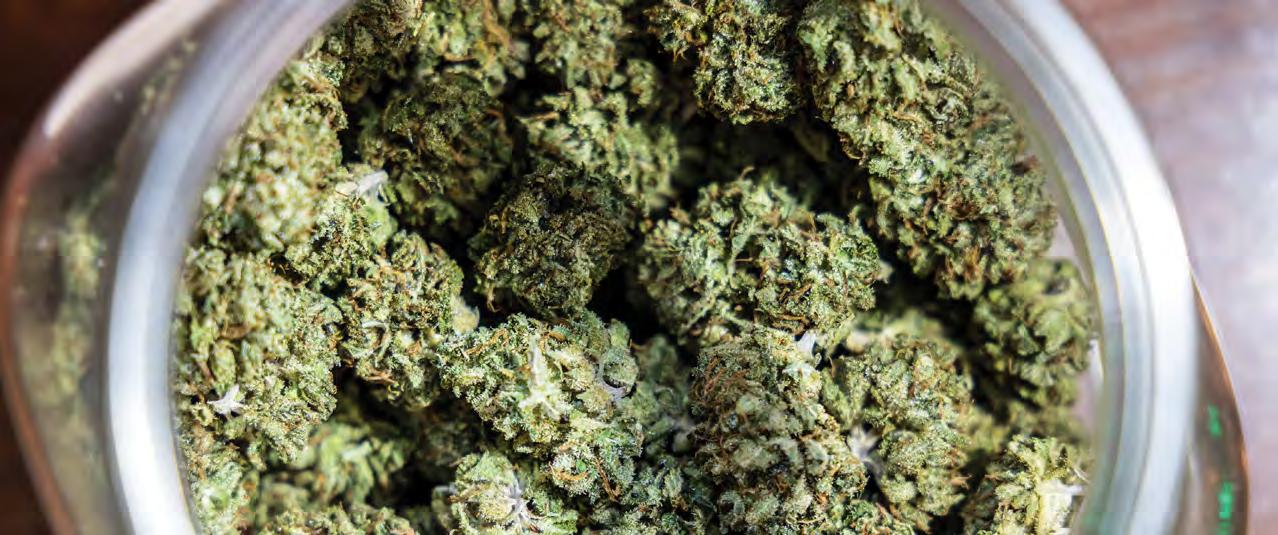
16 minute read
Clinical Pharmacology of Cannabis Relevant to Dentistry
Clinical Pharmacology of Cannabis Relevant to Dentistry
Fran M. Gengo, PharmD, FCP
ABSTRACT
Cannabis is no longer an illicit drug but, rather, a drug whose use has dramatically increased because its recreational use is largely legal and its use in medicine has demonstrated efficacy in the treatment of many difficult-to-treat disorders, including chronic pain, spasticity and several cancer-related problems, to name a few.
This change represents several new challenges for dentists. Chronic cannabis use can increase the prevalence and severity of periodontal disease and dental caries. Cannabis also has been shown to alter the clinical pharmacokinetics and the magnitude of the clinical actions of many pharmacologic agents frequently used by dentists. This includes but is not limited to, local anesthetics, nonsteroidal anti-inflammatory drugs, medications with anticholinergic activity, opiates and sedative/anxiolytic medications.
This review is intended to provide the practicing dentist with an overview of the pharmacology and pharmacokinetics of cannabis, as well as a catalog of medications used in dentistry whose actions can be clinically altered in patients who frequently use cannabis.
Cannabis products are derived from the plant Cannabis sativa. Hence, patients using cannabis are taking an entourage of constituents, including major cannabinoids delta-9-tetrahydrocannabinol (∆9THC), cannabidiol (CBD) and cannabinol (CBN), as well as other cannabinoids and non-cannabinoid phytochemicals, such as terpenes. Most of the constituents of the cannabis plant have some pharmacologic activity. The pharmacologic activity of the noncannabinoid phytochemicals is the least well-understood, though rapidly evolving. Much more is known about the two main cannabinoids, ∆9THC and CBD.[1-3]
∆9THC is the cannabinoid with the most potent central nervous system activity. It binds to endogenous cannabinoid receptors to produce its CNS effects. ∆9THC is metabolized to an array of cannabinoid metabolites; only the 11-hydroxy-THC metabolite has relevant psychopharmacologic activity, though its relative potency compared to ∆ 9THC in humans is not clear, it is less than that of ∆9THC.[4]
When cannabis is absorbed through the lungs as a vaporized solution or smoked raw plant leaves, bioavailability of ∆9THC is reported to be around 25%, ranging from 2% to 56%, with several sources of variability. CBD bioavailability is reported around 31%, ranging from 11% to 45%. Following smoking, vaping or sublingual absorption via the buccal mucosa (i.e., tinctures), ∆9THC and CBD concentrations rise extremely quickly and then begin to decline.[5] Most first-pass hepatic metabolism is bypassed, so systemic uptake of ∆THC is high, but the production of the active ∆9THC metabolite 11-hydroxy-THC is very limited. Conversely, when cannabis is consumed orally and swallowed,
absorption of ∆THC and CBD is much slower and more limited due to the low-lipid solubility of the solution and significant first-pass hepatic metabolism. However, while delayed, production of the pharmacologically active 11-hydroxy-THC metabolite is much greater than when cannabis is smoked or vaped.[6,7] (Figure 1).

The absorption of oral formulations, such as tablets or capsules, is slower and more limited than the oral tinctures. Accordingly, cannabis preparations, either as medical cannabis or as recreational cannabis, when taken orally have a much slower onset of action and much longer duration of action.
Evaluating Your Patient: Treat or Not Treat
Just as you would never consider providing dental treatment to a patient inebriated from alcohol, you should never knowingly treat a patient under the influence of cannabis. However, unlike alcohol, impairment from cannabis can be much more challenging for the clinician to detect.
Unlike alcohol, there is no reliable chemical analysis that will rule in or out cannabis intoxication. Some dental offices may have a low-cost portable ethanol breath test device to assist them in evaluating patients suspected of being under the influence of alcohol. A breath alcohol concentration higher than 0.08 gm/2100L is considered legally intoxicated, and the patient should not be treated or allowed to drive home.
With cannabis, there is no analogous device that could be used in a dental office. Even if such a device were to become available, it would not be of use since there is no reliable relationship between breath or mouth fluid cannabis concentrations and the magnitude of cannabis impairment. Even with state-of-the-art gas chromatography/mass spectroscopy analysis of blood cannabis concentrations, there has been no consensus regarding a “per se” cannabis blood concentration associated with impairment/intoxication.
The 2017 Department of Transportation National Highway Traffic Safety Administration Marijuana-Impaired Driving Report to Congress states, “While fewer studies have examined the relationship between THC blood levels and degree of impairment, in those studies that have been conducted the consistent finding is that the level of THC in the blood and the degree of impairment do not appear to be closely related. Peak impairment does not occur when THC concentration in the blood is at or near peak levels. Peak THC levels can occur when low impairment is measured, and high impairment can be measured when THC level is low. Thus, in contrast to the situation with alcohol, someone can show little or no impairment at a THC level at which someone else may show a greater degree of impairment.” (Compton 2017)[8]
Further, a 2009 study showed that “some participants showed no impairment in motor control even at THC serum concentrations higher than 40 ng/ml.” (Hunault et al. 2009)[8,9]
In addition, urine testing for cannabis fails to provide useful information to assist in determining cannabis intoxication since urine testing measures only the pharmacologically inactive metabolite of ∆9THC, ∆9Carboxy THC. This provides the clinician with no information about cannabis dose, time of consumption or likelihood of impairment. It is also more challenging to clinically assess a patient for cannabis impairment as compared to alcohol impairment. In this the clinician faces the same challenge as the law enforcement community in assessing drivers suspected of cannabis impairment. Recent publications have reported that the established “Standardized Field Sobriety Tests” used by law enforcement for field evaluation of drivers suspected of ethanol intoxication are not reliable in cannabis impairment.[7]
The International Drug Evaluation & Classification Program provides some direction. This program, used by law enforcement, indicates that individuals “under the influence of cannabis” will have an elevated heart rate and blood pressure, dilated pupils, conjunctival injection, and impaired time and distance perception. While this evaluation tool has been shown to result in significant false positives, it may be useful to the dental clinician, since the consequence of a false positive may only be a rescheduled clinic visit rather than arrest and possible incarceration.[10]
Like so many other aspects of dentistry, the evaluation of the patient when the dentist suspects cannabis intoxication relies heavily upon the clinician’s clinical judgment.
Medical vs. Recreational Cannabis
Medical cannabis and recreational cannabis have been shown to contain similar content of cannabinoids.[12] However, patients using medical cannabis in New York State are under the ongoing medical monitoring of the prescribing physician. In general, the dose of THC and the ratio of THC:CBD, the number of refills, etc., are monitored as part of the patient’s ongoing medical care. Because the goal of therapy with medical cannabis is to produce efficacy without adverse effects, including impairment, these patients should not receive dental treatment “under the influence” of cannabis.
In New York State, a specially certified medical provider must grant an individual prescription for a qualified patient to be treated with medical cannabis. Initially, state regulations required that patients treated with medical cannabis have one of the following conditions:
• Chronic Pain
• Neuropathy / Radiculopathy
• Cancer
• PTSD (Post Traumatic Stress Disorder)
• Epilepsy
• Inflammatory Bowel Disease (IBD)
• Multiple Sclerosis (MS)
• Huntington’s Disease and other Movement Disorders
• Migraine

This has recently expanded access to medical cannabis to all patients who may benefit as determined by provider’s medical discretion. Certified medical providers recommend a specific medical cannabis formulation, specific THC:CBD ratio, and/or dose for each patient. The medical cannabis may only be obtained by patients at licensed dispensaries.
At the Dent Neurologic Institute, we offer medical cannabis for an array of neurologic disorders, including headache, multiple sclerosis, Parkinson’s disease, neuropathies, concussion, brain tumor and trigeminal neuralgia.[13]
Our experience has been that, while medical cannabis efficacy varies between the various neurologic disorder being treated, patients tolerate medical cannabis well. Doses are titrated and monitored to provide clinical efficacy without impairment. In addition to symptomatic improvement in these disorders, we have found medical cannabis treatment results in dose reduction or discontinuation of opioid analgesics in patients with multiple sclerosis. Patients prescribed medical cannabis for migraines have reported improvement in migraine profile and common comorbidities, and there was a reduction in prescription medication, especially opioids. Side effects exist, with the majority being mild, and patients rarely reported symptoms of cognitive impairment.
Because of the above, patients presenting for dental care who are being treated with medical cannabis are not likely to be impaired because of their medical cannabis treatment. Unless the patient is obviously impaired, there should be no reason to limit or modify dental procedures, or non-pharmacologic dental treatments.
Drug-Drug Interactions in Dentistry
There is a paucity of clinical data regarding drug-drug interactions with cannabis because clinical research with cannabis is limited by the federal government, which continues to classify cannabis as a Schedule I controlled substance. The federal classification continues despite New York State’s legalization of both medical and recreational cannabis. The Schedule I federal classification is defined as drugs with no currently accepted medical use and a high potential for abuse. Some examples of Schedule I drugs include heroin, lysergic acid diethylamide (LSD), marijuana (cannabis), 3,4-methylenedioxymethamphetamine (ecstasy), methaqualone and peyote. Clinical research involving Schedule I compounds requires federal certification that is beyond most clinical research facilities.[24]
There are, however, at least three known major mechanisms of drug interactions that involve ∆THC and or CBD. These include:
1. Pharmacodynamic Interactions: medications with CNS depressant or anticholinergic activity.
2. Protein-binding displacement of highly protein-bound drugs by ∆9THC or CBD.
3. Overlap with cytochrome P450 hepatic isoenzymes or other drug metabolizing enzymes.
Cannabis and Medications with Anticholinergic Effects
Well-known effects of cannabis include temporary xerostomia and tachycardia. Relevant to dentistry, this anticholinergic-induced xerostomia can raise the risk of tooth decay, increasing the importance of good dental hygiene in frequent cannabis users. There is evidence this anticholinergic activity of cannabis contributes to ∆9THC-induced tachycardia and blood pressure elevations.[16] Therefore, the use of any medications with additional anticholinergic effects would be expected to make cardiovascular effects more severe.

In a 1976 study authored by Benowitz and Jones, cardiovascular responses to isoproterenol, atropine and/or propranolol were measured before and after ingesting ∆9THC capsules for 14 days. This study found significantly increased heart rates during ∆9THC ingestion after atropine +/- propranolol administration and noted that atropine at doses of 0.02 mg/kg and higher may induce hypertension in patients using ∆9THC. Dentists are cau-
tioned about the use of known anticholinergic medications in patients frequently using cannabis, including atropine, diphenhydramine, chlorpheniramine, promethazine doxylamine and hydroxyzine. There are, however, many other medications not commonly thought of as anticholinergic medications that produce anticholinergic effects, including furosemide, oxybutynin, trazadone, amitriptyline and carisoprodol.
Cannabis and Local Anesthetics
It is important that patients who are chronic users of cannabis, even while “not under the influence,” never be treated with local anesthetics containing epinephrine. As described earlier, the pharmacokinetics of cannabis are such that concentrations of ∆9THC can linger for several days, long after the observable CNS effects have dissipated. These patients, when treated with an epinephrine-containing local anesthetic, can experience clinically serious tachycardia, peripheral vasodilatation and oxygen desaturation with elevated risk of cerebral or myocardial infarction.[17,18]
Cannabis and CNS Depressants used to Pre-Medicate Anxious Patients
∆9THC has been shown to interact with CNS depressants to pharmacodynamically increase their CNS depressant effects. The literature is replete with studies examining the interaction between ∆9THC and barbiturates and found additive pharmacodynamic effects.[17,55]
There is a similar exaggeration of the effects of benzodiazepines and cannabis. This is not unexpected since the molecular effects of ∆9THC in the brain are at least partially mediated at central nervous system benzodiazepine receptors. However, in addition to the pharmacodynamics synergism between ∆9THC and benzodiazepines, these compounds can interact, increasing CNS depression when there is completion for or inhibition of drug-metabolizing enzymes. Because of this, when benzodiazepines must be used in dental patients who are frequent users of cannabis, they should be used in the lowest possible doses, and those benzodiazepines that undergo the least hepatic iso enzymatic metabolism, such as lorazepam or oxazepam rather than diazepam.[19,20]
Cannabis and Opioids
Several studies have demonstrated that cannabis can have an opioid-sparing effect in populations of chronic pain patients.[21,22] This means that when cannabis is co-administered with opioids, many patients are able to reduce or discontinue opioid use. A study of 21 chronic pain patients taking morphine or oxycodone found that administration of vaporized cannabis did not significantly alter plasma opioid levels but resulted in significantly decreased pain.[?] This indicates a pharmacodynamic interaction between opioids and cannabis, resulting in significant pain reduction.
This opioid-sparing effect of cannabis, however, is only relevant in patients chronically using opiates, and who have developed a degree of tolerance to the CNS depressant effects of opiate. The use of opiates in dentistry is much more likely for the acute analgesic effects in opiate-naïve patients. In this setting, a patient also frequently using cannabis is much more likely to experience an enhanced CNS depression when opiates are prescribed, including respiratory depression. Hence, dentists should use caution or avoid use of opiates in patients who are chronic cannabis users.
Cannabis and NSAIDS
Nonsteroidal anti-inflammatory drugs (NSAIDS) are frequently used following dental procedures, including extractions and endodontic procedures. While the use of these analgesics in frequent cannabis users is much safer than the use of short-term opiates, the metabolism of many NSAIDS is affected by ∆THC or CBD. There are important drug metabolism pathways inhibited by ∆THC or CBD. Those most relevant to dentistry would include ibuprofen, naproxen, diclofenac and meloxicam. These medications produce effects in addition to analgesia, including inhibition of platelet aggregation and elevation of blood pressure. In each of these cases, if a dental patient is known to be a frequent user of medicinal or recreational cannabis, use of a lower dose should be considered to avoid bleeding complications and elevated blood pressure.[23]
Medications with Potential to Interact with Cannabis
CBD is known to inhibit several hepatic isoenzymes and UDP glucuronosyltransferase enzymes involved in the metabolism of many common pharmaceuticals. Both ∆9THC and CBD can either inhibit or compete for various hepatic isoenzymes.
Summary
Whether because of decriminalization/legalization of marijuana laws or the growing number of patients using medical cannabis, the dentist will be faced with understanding how cannabis might affect his/her practice. This includes evaluation of potentially cannabis-impaired patients presenting to the office, as well as how cannabis use by patients might affect medications commonly prescribed by dentists.
The author has declared no financial interests. Queries about this article can be sent to Dr. Gengo at fgengo@dentinstitute.com.
REFERENCES
1. ElShohly MA, Slade D. Chemical constituents of marijuana: the complex mixture of natural cannabinoids. Life Sciences 2005;78(5):539-548.
2. ElSohly MA, Radwan MM, Gul W, Chandra S, Galal A. Phytochemistry of cannabis sativa L. Phytocannabinoids 2017:1-36.
3. Russo EB. Taming THC: potential cannabis synergy and phytocannabinoid-terpenoid entourage effects. British Journal Pharmacology 2011;163(7):1344-1364.
4. Martin BR, Kallman MJ, Kaempf GF, Harris LS, Dewey WL, Razdan RK. Pharmacological potency of R- and S-3’-hydroxy-delta 9-tetrahydrocannabinol: additional structural requirement for cannabinoid activity. Pharmacol Biochem Behav 1984;21(1):61-65.
5. Grotenhermen F. Pharmacokinetics and pharmacodynamics of cannabinoids. Clin Pharmacokinet 2003;42(4):327-360.
6. Wall ME, Sadler BM, Brine D, et al. Metabolism, disposition, and kinetics of delta-9-tetrahydrocannabinol, in men and women. Clin Pharmacol Ther 1983;34(3):352–63A.
7. Huestis MA, Henningfield JE, Cone EJ. Blood cannabinoids: I. absorption of THC and formation of 11-OH-THC and THCCOOH during and after smoking marijuana. J Anal Toxicol 1992;16(5):276–82.
8. Marcotte TD, Umlauf A, Grelotti DJ, et al. Evaluation of field sobriety tests for identifying drivers under the influence of cannabis: a randomized clinical trial. JAMA Psychiatry 2023;80(9):914-923.
9. Transportation Safety Initiative (Rev.2018, February). Drug Recognition Expert Course Participant Manual. National Highway Traffic Safety Administration.
10. Gengo FM, Kirsch JM, Janofsky JS. A Critical Evaluation of the Scientific and Statistical Validity of the Drug Recognition Evaluation (DRE) Program. In Inside the Minds: Understanding DUI Scientific Evidence 2012 (pp. 139-170). Aspatore Books.
11. Aladeen TS, Mattle AG, Zelen K, Mesha M, Rainka MM, Geist T, Myers B, Mechtler L. Medical cannabis in the treatment of Parkinson’s disease. Clinical Neuropharmacology 2023;46(3), 98–104.
12. Mechtler LL, Gengo FM, Bargnes VH. Cannabis and migraine: it’s complicated. Curr Pain Headache Rep 2021 Feb 25;25(3):16.
13. Rainka MM, Aladeen TS, Mattle AG, Lewandowski E, Vanini D, McCormack K, Mechtler L. Multiple Sclerosis and use of medical cannabis: a retrospective review of a neurology outpatient population. Int J MS Care 2023 May-Jun;25(3):111-117.
14. Hart P, Mechtler L, Ralyea C, Bargnes V, Benyovszky A, Wang Y, & Kerling D. (2021). Medical Cannabis in the Treatment of Neuropathy (4596). Neurology, 96 (15_supplement), 4596.
15. Hendrick JR, Hendrick LG. Cannabis: what dental providers need to know. RDH, 2021, Dec 8.
16. Rechthand M, Bashirelahi N. What every dentist needs to know about cannabis. Gen Dent 2016;64(1):40-43.
17. Gengo FM, Mattle AG, Ralyea Jr CC. Cannabis – Drug Interactions: Implications for Medicinal Cannabis Use. In: Medicinal Usage of Cannabis and Cannabinoids. Martin, Patel, & Preedy. Academic Press. 2023 Jun 2. 297-317.
18. Hasanpoor A, Akaberi M, Kesharwani P, Sobhani Z, Sahebkar A. Drug interactions with cannabis sativa: Mechanisms and clinical implication. Toxicologie Analytique et Clinique. 2023 Nov 3.
19. Brown JD. Potential adverse drug events with tetrahydrocannabinol (THC) due to drug-drug interactions. J Clin Med 2020;9(4):919. Published 2020 Mar 27.
20. Greenblatt DJ, Shader RI, Divoll M, Harmatz JS. Benzodiazepines: a summary of pharmacokinetic properties. Br J Clin Pharmacol 1981;11 Suppl 1(Suppl 1):11S-16S.
21. Nielsen S, Sabioni P, Trigo JM, et al. Opioid-sparing effect of cannabinoids: a systematic review and meta-analysis. Neuropsychopharmacology 2017;42(9):1752-1765.
22. D I Abrams 1, P Couey, S B Shade, M E Kelly, N L Benowitz Cannabinoid-opioid interaction in chronic pain. Clin Pharmacol Ther. 2011 Dec;90(6):844-51.
23. Rongrong Jiang 1, Satoshi Yamaori 1, Yasuka Okamoto 1, Ikuo Yamamoto 2, Kazuhito Watanabe 1 3Cannabidiol Is a Potent Inhibitor of the Catalytic Activity of Cytochrome P450 2C19Drug Metabolism and PharmacokineticsVolume 28, Issue 4, 2013, Pages 332-338.
Fran M. Gengo, PharmD, FCP, is associate professor, University at Buffalo, departments of Pharmacy and Neurology, and chief science officer and director, Neuropharmacology Division, Dent Neurologic Institute, Amherst, NY.











